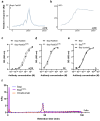Reducing neonatal Fc receptor binding enhances clearance and brain-to-blood ratio of TfR-delivered bispecific amyloid-β antibody
- PMID: 38634473
- PMCID: PMC11028011
- DOI: 10.1080/19420862.2024.2339337
Reducing neonatal Fc receptor binding enhances clearance and brain-to-blood ratio of TfR-delivered bispecific amyloid-β antibody
Abstract
Recent development of amyloid-β (Aβ)-targeted immunotherapies for Alzheimer's disease (AD) have highlighted the need for accurate diagnostic methods. Antibody-based positron emission tomography (PET) ligands are well suited for this purpose as they can be directed toward the same target as the therapeutic antibody. Bispecific, brain-penetrating antibodies can achieve sufficient brain concentrations, but their slow blood clearance remains a challenge, since it prolongs the time required to achieve a target-specific PET signal. Here, two antibodies were designed based on the Aβ antibody bapineuzumab (Bapi) - one monospecific IgG (Bapi) and one bispecific antibody with an antigen binding fragment (Fab) of the transferrin receptor (TfR) antibody 8D3 fused to one of the heavy chains (Bapi-Fab8D3) for active, TfR-mediated transport into the brain. A variant of each antibody was designed to harbor a mutation to the neonatal Fc receptor (FcRn) binding domain, to increase clearance. Blood and brain pharmacokinetics of radiolabeled antibodies were studied in wildtype (WT) and AD mice (AppNL-G-F). The FcRn mutation substantially reduced blood half-life of both Bapi and Bapi-Fab8D3. Bapi-Fab8D3 showed high brain uptake and the brain-to-blood ratio of its FcRn mutated form was significantly higher in AppNL-G-F mice than in WT mice 12 h after injection and increased further up to 168 h. Ex vivo autoradiography showed specific antibody retention in areas with abundant Aβ pathology. Taken together, these results suggest that reducing FcRn binding of a full-sized bispecific antibody increases the systemic elimination and could thereby drastically reduce the time from injection to in vivo imaging.
Keywords: Alzheimer’s disease (AD); amyloid-β (aβ); bispecific antibody; blood-brain barrier (BBB); neonatal Fc receptor (FcRn); receptor mediated transcytosis (RMT).
Conflict of interest statement
Ken G. Andersson is an employee of BioArctic AB, Sweden. The other authors have no conflicts of interest to declare.
Figures





Similar articles
-
Fluorine-18 ImmunoPET Imaging of Antibody Brain Kinetics and Amyloid-Beta Pathology.ACS Pharmacol Transl Sci. 2025 Jul 11;8(8):2804-2813. doi: 10.1021/acsptsci.5c00359. eCollection 2025 Aug 8. ACS Pharmacol Transl Sci. 2025. PMID: 40810143
-
High-affinity transferrin receptor binding improves brain delivery of bispecific antibodies at tracer dose.Fluids Barriers CNS. 2025 Aug 21;22(1):86. doi: 10.1186/s12987-025-00693-2. Fluids Barriers CNS. 2025. PMID: 40842024 Free PMC article.
-
ImmunoPET imaging of amyloid-beta in a rat model of Alzheimer's disease with a bispecific, brain-penetrating fusion protein.Transl Neurodegener. 2022 Dec 26;11(1):55. doi: 10.1186/s40035-022-00324-y. Transl Neurodegener. 2022. PMID: 36567338 Free PMC article.
-
Re-engineering therapeutic antibodies for Alzheimer's disease as blood-brain barrier penetrating bi-specific antibodies.Expert Opin Biol Ther. 2016 Dec;16(12):1455-1468. doi: 10.1080/14712598.2016.1230195. Epub 2016 Sep 7. Expert Opin Biol Ther. 2016. PMID: 27572805 Review.
-
Clearance of amyloid-beta peptide across the blood-brain barrier: implication for therapies in Alzheimer's disease.CNS Neurol Disord Drug Targets. 2009 Mar;8(1):16-30. doi: 10.2174/187152709787601867. CNS Neurol Disord Drug Targets. 2009. PMID: 19275634 Free PMC article. Review.
Cited by
-
The effects of dose, valency, and affinity on TfR-mediated brain delivery in vivo.Fluids Barriers CNS. 2025 Apr 8;22(1):36. doi: 10.1186/s12987-025-00643-y. Fluids Barriers CNS. 2025. PMID: 40200213 Free PMC article.
-
A brain-penetrant bispecific antibody lowers oligomeric alpha-synuclein and activates microglia in a mouse model of alpha-synuclein pathology.Neurotherapeutics. 2025 Mar;22(2):e00510. doi: 10.1016/j.neurot.2024.e00510. Epub 2024 Dec 14. Neurotherapeutics. 2025. PMID: 39676023 Free PMC article.
-
Single domain antibody-scFv conjugate targeting amyloid β and TfR penetrates the blood-brain barrier and interacts with amyloid β.MAbs. 2024 Jan-Dec;16(1):2410968. doi: 10.1080/19420862.2024.2410968. Epub 2024 Oct 2. MAbs. 2024. PMID: 39358860 Free PMC article.
-
Targeting Brain Drug Delivery with Macromolecules Through Receptor-Mediated Transcytosis.Pharmaceutics. 2025 Jan 15;17(1):109. doi: 10.3390/pharmaceutics17010109. Pharmaceutics. 2025. PMID: 39861756 Free PMC article. Review.
-
Nuclear Imaging of Bispecific Antibodies on the Rise.J Nucl Med. 2024 Oct 1;65(10):1512-1517. doi: 10.2967/jnumed.123.267215. J Nucl Med. 2024. PMID: 39266295 Free PMC article. Review.
References
-
- FDA . FDA grants accelerated approval for Alzheimer’s disease treatment. 2023. [accessed 2023 Jan 6 https://www.fda.gov/news-events/press-announcements/fda-grants-accelerat....
-
- Cavazzoni P. (FDA C. for D. E. and R. FDA’s decision to approve new treatment for Alzheimer’s disease. Fda’s decision to approve new treatment for Alzheimer’s disease 2021. https://www.fda.gov/drugs/news-events-human-drugs/fdas-decision-approve-....
MeSH terms
Substances
LinkOut - more resources
Full Text Sources
Medical
